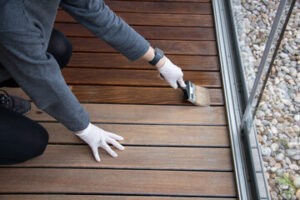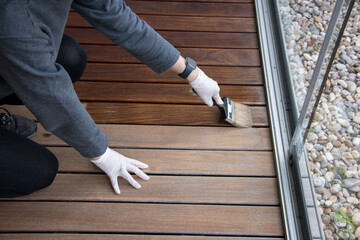Hardwood floors are beautiful and add a luxurious feel to any room. But they can also wear down over time, requiring refinishing or resealing to keep them looking new.

When refinishing your hardwood floors, it is essential to use the right products. Experts at Hardwood Floor Refinishing Bergen County NJ is trained in properly using the full line of professional products from sanding to finishing.
Before refinishing hardwood floors it is important to take the time to survey your floor and determine what needs to be done. This includes noticing any scratches, dents, and overall damage to the surface. Depending on your desired finish this information can help you choose the type of stain and how many coats you need to apply.
It is also a good idea to remove all furniture and other items from the room. Taking the time to do this can help prevent accidental damage and will make the entire process run smoother. If you decide to move your furniture yourself make sure you have a dolly and protective sheets to protect your furniture. It is also a good idea to cover any vents, windows and doors with plastic sheets and painters tape. This will help keep dust from traveling throughout your home during the refinishing process.
Once the room has been cleared it is important to prep the floors for sanding. This can include vacuuming, sweeping and cleaning with hardwood floor cleaner. Depending on the age of your floors and the current finish, you may need to be aggressive with your sanding. You can start by using 36-grit sandpaper, but if the floors have been painted in the past you will likely need to go even coarser.
After sanding, your floors will need to be stained and allowed to dry. Choosing the right stain is an important step in refinishing your hardwood floors. A light to mid-tone will show fewer marks than a dark or rich tone.
It is important to hire a professional for the refinishing of your hardwood floors. If you are not experienced with this type of work it is easy to damage the floors or make mistakes that cannot be fixed. A professional will have the proper equipment to get the job done correctly and quickly.
Stain
Wood floors are beautiful and functional in their natural state, but they can be even more stunning with the addition of a stain. This process can dramatically change the color of your floors and is a key step in hardwood floor refinishing.
Before the stain is applied, your floors will be sanded and prepped to create a smooth surface for the new finish. Depending on your personal preferences, you may want to opt for a lighter or darker stain than what the floor originally had. Stain colors can range from a rich espresso to a light caramel hue. The choice of a stain will depend on the color that best complements your home décor as well as how much natural sunlight the room receives.
Staining your hardwoods is a big decision, and one that should not be taken lightly. If the wrong stain is selected and then applied, it can require a full re-sanding of the entire flooring, resulting in additional time and cost. That’s why it’s important to get a professional opinion on your floor’s stain color and options.
If your floors have major scratches or gouges that cannot be resolved with regular cleaning and buffing, stain might be the answer for your floor. However, it is important to note that a stain will not completely cover the scratch or gouge and that these marks will be visible under your protective coating.
Before choosing a color for your stain, have your hardwood floor professional provide some larger sample panels for you to try out on the actual floors in your home. They can either put the samples directly on the floor after sanding a section or make some portable stain samples for you to take home with you.
Varnish
Hardwood floors are a great addition to any home and they can last for decades with regular care. The most important thing for keeping your hardwood floor in great shape is a finish, which protects it from damage and gives it a beautiful sheen. Finishes come in a variety of options, including varnish and polyurethane. Both have unique advantages, and the right one for your floor will depend on factors like your preferred style, where your floors are located and your budget.
Varnish is the traditional floor finish that has been used for centuries and is known to enhance wood grain. It’s also easier to apply than polyurethane, making it a good option for DIYers. However, both varnish and polyurethane require a thorough prep process to ensure a smooth, even coat. Vacuuming and sweeping are essential for removing any dust particles before beginning the finishing process. You’ll also want to remove any furnishings and drapes from the work area and make sure your family or pets aren’t in the way.
To prepare your hardwood floor for a new coat of varnish, it’s necessary to sand it. Sanding is a step-down process that involves using progressively finer grits of sandpaper until the existing layer of finish is leveled with the surrounding wood. Professionals use a drum or belt sander for the main floor area, and an edge sander to take care of corners and edges.
After sanding, it’s crucial to vacuum the entire area again and clean with a damp (not wet) mop. Vacuuming will help remove any lingering dust particles, and the damp mop will help to prevent spots from drying out too quickly. You should wait 24 hours before walking on the floor, and it’s a good idea to let it dry completely for a few days before moving furniture back into the space.
Sanding
Hardwood floors bring a classic elegance to a home that isn’t easily replicated by other flooring. They can last for years, but eventually will need refinishing to keep them looking great and to help the new coat of stain or varnish adhere. Refinishing your hardwood floors can take from four to seven days and is a labor-intensive project. But doing it correctly will give your hardwoods a beautiful, lasting finish that will look like they were installed yesterday.
First, you need to remove everything that can’t be moved out of the room, such as furniture and baseboards. Then, you need to clean the floor thoroughly, and if necessary, do some repairs to gouges and cracks. Next, you’ll need to vacuum and dust mop the floor to remove all of the dirt and grit from the surface. This step is especially important if the floors have been waxed or oiled.
Finally, you’ll need to sand the floors. Ideally, you’ll want to use a sander with a coarse grit to rough up the surface of the wood and then switch to a finer grit for the smoothing process. This will help to level out the scratches left behind by the coarse sandpaper and make the floor ready for staining or varnishing.
Once you’ve finished sanding, it’s time to evaluate whether or not your hardwood needs a full refinish or if it could benefit from a simple screen and recoat. This is a much less expensive option that fixes problems in the surface-level protective covering, but it can’t fix severe scratches or discoloration. A good contractor will be able to help you determine the best solution for your floors.
Resealing
Hardwood floors are a staple in many homes and add an elegant touch to any space. They are also very durable, and if properly maintained, they can last a lifetime. However, over time, they can lose their shine and become worn down. Hardwood floor refinishing is a process that restores the original beauty of your hardwood floors and extends their lifespan. Refinishing is a more extensive process than recoating and requires sanding and staining your hardwood floors. However, it will leave you with what look like brand new hardwood floors.
Refinishing also helps to resolve issues that can’t be fixed by resealing, such as major scratches and gouges in your hardwood floors. It is also a good option for changing the stain color of your hardwood floors, as well as for floors that have been damaged by water. The only drawback to refinishing is that it can be more expensive and take longer than resealing, but the results are worth it.
Another common issue with hardwood floors is discoloration from excessive exposure to sunlight. This can be caused by fading or scrubbing, which can cause the wood to crack and peel. Refinishing can help prevent this from happening and will ensure your floors are protected against sunlight.
There are several different types of finishes available for your hardwood floors, including water based, polyurethane and acid cured. Each type has its own benefits and disadvantages, and the best choice for your home will depend on your lifestyle, needs, and personal preferences. For example, water based finishes are more environmentally friendly but they can be less durable, while polyurethane is the most popular and provides a high-quality finish that is easy to maintain.
